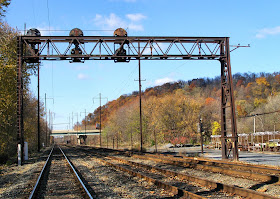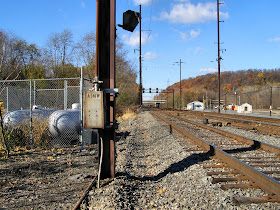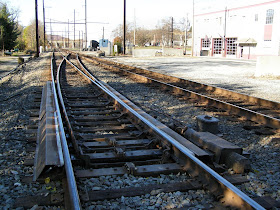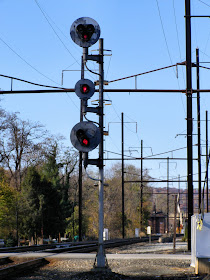Both towers' design also reflected an evolving trend in PRR interlocking tower design away from the trademark bay window types to the new "corridor" type tower that would appear in the 1940's. Still, the PRR spared little expense with brick construction, a slate roof and all the luxury amenities such as indoor plumbing and central heat.
Like THORN, COLA was an all relay interlocking plant wit a US&S CTC console interface (although as I explained before there was very little Rule 261 "CTC" involved in the project). One advantage of the PRR's foresight was that in the 1980's when the tower was ultimately closed the windows could simply be bricked up and a remote unit installed to replace the human operator flipping toggles on the unit lever machine. This means that COLA essentially was un-resignaled from 1938 through ~2011. Anyone who says that modern solid state ICs and printed circuit boards are more reliable let's see how many modern electronic devices are still functioning after 70 years in service and if replacement parts are still available.
From 1938 until its re-signaling in 2011 COLA used pneumatic switch machines with the compressor plant being located in the basement of the tower. The air reservoirs and dryer was located to the rear of the tower's exterior. Note the cables running into the tower from the CTC code line that ran from SHOCKS to CRESS.
It's status as a functioning relay room also meant that COLA tower had the privilege of wearing the Conrail blue reflective nameplates in addition to the high security brick job over almost every single exterior opening. I would not be surprised if the CTC console was active for local control right up until the end. Also note the tower's door and slate shingled canopy. Classy.
Thanks to the internet I managed to track down an a photo of the COLA operator sitting at the CTC console around 1980. If you visited the THORN page you can see that everything is essentially the same, only this console is a little larger. Note the HBD-DED readouts in the background. For those of you who like their facts and figures COLA had a 150 unit lever CTC console broken out into the following categories.
- 23 levers for 53 signals
- 27 levers for 40 switches
- 4 levers for 6 electric locks
- 1 traffic lever
- 2 levers for overhead wire sectionalizin
I am not 100% sure what the exact function of this supplementary relay room was, but it matches a similar one at LAKE as well as a number of structures on the Buffalo Line. My guess is that it is the location of the CTC code line equipment that was possibly turned into a maintainers workshop.
So we've talked a bit about COLA tower and taken a quick circle around the outside so let's actually take a look over the interlocking. At first glance COLA has a rather odd layout with tracks coming in all over the place, however a better way to conceptualize it is a flat junction between two double track ABS lines with a pair of sidings and some yard leads. There are both facing and trailing ladders covering all tracks and some capacity for parallel movements. Also sidings between LAKE, COLA and MANOR interlockings are all terminated with access to/from all main tracks.
I could go on and on trying to analyze how COLA was originally built, but what I actually have photos of is how COLA ended up after Conrail was done rationalizing it back in the late 1980's. Long story short there is not a lot left as one can see in this eastbound view of the tower showing the Columbia branch diverging to the left. In the foreground past the crossing is where the 41, 43, 47 ladder would have plugged into the Columbia branch and the 45 switch off the Manor siding would have gone back into the westbound main track.
Looking in the opposite direction towards the old Rt 30 bridge we see the tracks splitting to make room for the center siding track that ran to LAKE interlocking. This is about where the extra long 59 turnout running between the westward main and eastward Columbia branch would have been. Note to the remains of the electrification and the two 138kV 25hz transmission lines, one of which remains active to this day connecting the Roy Substation to the Safe Harbor Dam. Columbia did have its own substation that was located about where the white building visible under the bridge now stands. Note the two pairs of 6kv 100Hz signal power supplies. One for the Columbia Branch, the other for the A&S/Port Road.
Regarding the substation you can still see where the surviving 12kv catenary feeds turn off to towards it. Two of the feeds supplied the Columbia branch at a point just past the tower.
Westbound trains off the Columbia Br. saw two PRR PL mast signals, the 56R, which protected a number of electrically locked industrial sidings, and then the 52R. Both remained after the Columbia Branch was single tracked and the best indication both could provide was Slow Approach. Not realizing the 56R existed when I visited COLA interlocking in 2007 I only have photos of the 52R, seen here. Note the 80 mile marker behind the signal. This was measured from Philadelphia and represented the old Philadelphia and Columbia railroad heritage, which was incorporated into the PRR back in 1857.
The 52R's lower head shows evidence of having some recent maintenance applied to it.
Back in the day the 52R would protect the grade crossing and then allow trains occupy the 51 switch before facing the 64R dwarf signal. With the 51 switch removed, trains off the Columbia would pass a total of three signals before actually hitting an interlocking appliance. Here is the 64R dwarf as it appeared in 2007.
NS, not being stupid, removed both legacy signals in their 2011 re-signaling effort and replaced this dwarf with a new slow speed mast signal.
The 64R signal protects the 69 switch that provides access to one of two leads into the small Columbia freight yard, which today is basically some dump tracks for MoW and the like.
Closeup of the 69 switch A-5 pneumatic point machine.
Traffic from that lead was governed by the 64LB signal displaying either Restricting or Stop.
If you are thinking that PRR PL dwarf signal looks a little odd you would be right as this is one of the left handed model that was used in the 1930's until the PRR decided that it would be better to make the Restricting \ smaller than the Slow approach /. Also this model used two side mounted access hatches instead of a single removable backplate. The design also has a bit of an art deco flare.
The 64R also protected the 77 switch which accessed a running track that eventually tied back into the westbound main via the 85 lever electrically locked hand throw switch. In this view we can see both the 69 and 77 switches as well as the catenary gantry that fed the 12kv and 6kv lines into the substation in addition to supporting the local section breaks.
77E A-5 machine with shrouded burner type point heaters.
Traffic off the runner was governed by the 64LC dwarf signal.
The 77 switch is actually a crossover with an east and west set of points. The switch is part of the old 73, 75, 77 ladder and the 77 and 75 points are back to back on the westbound main track.
The 73 switch is the second remaining crossover on the ladder with the 75 having been downgraded to a single turnout after the Y extension with the 61 and 71 switches on the center siding was removed. This allows access to the Columbia branch by eastbound trains on the Port Road. Hmmm, those points look suspiciously reverse.
Hmmm, might not be a good idea to turn on the point heaters with all those leaves piled high over the 73W A-5 point machine.
The eastbound 4-track (3-signal) signal bridge predates the 1938 re-signaling project as you can tell by the two sets of height extenders needed to get the older structure to clear the new overhead wires. As you can see railroads weren't as wasteful back in the day.
From left to right in this rear view the signals are the 74L, 76L and 78L. Train order lights were originally provided, but have since been removed.
Front view of the eastbound PRR signal bridge. Good news everyone! It appears that the 74L is displaying Slow Approach for a move onto the Columbia Branch.
While not re-signaling the interlocking, Conrail did wind up replace some signals such as the 74L, which is now sporting the telltale bolts of a Safetrain knockoff.
The other two signals were original. Here the 78L supports a medium speed indication for movements moving back onto the correct direction after the brief section of rule 261 operation between COLA and SHOCKS.
The 76L lost its medium speed indication when the 61/71 Y switch was removed leaving behind only the slow speed ladder.
Eventually NS GP38-2's #5658 and #5655 showed up with a short cut of cars.
Video of the train taking the ladder.
Moving on to some ancillary items here is one of the catenary section break motors along with the propane supply for the point heaters and the air line.
On the east side of the tracks was one of the original 1938 lead sealed CTC code lines seen here feeding into a wooden junction box. These would have replaced older open wire type code and telegraph lines.
Wooshing all the way back to the opposite end of the interlocking we find the sole surviving crossover from the trailing point ladder. The 41 switch compliments the 73/75 switch combination to provide a full crossover capability for the interlocking.
Air for the two pneumatic point machines operating the 41 crossover is provided by its own independent air plant, probably installed to retire a section of the original air line from the tower if you see how the old air line is cut.
This view of the far east end of the interlocking shows the distance between COLA tower and the 41 crossover.
At some point in the past Conrail replaced the two track westbound PRR signal bridge with a color light mast-dwarf combination, leading the old bridge standing behind them. Reason is unknown.
Here we see the Conrail style color light mast and dwarf under the old signal bridge. The retired PL signal positions on the bridge are for the 44R and 48R signals. The 48R was for movements off the Manor siding and would have been redundant after that siding was removed. Reverse direction movements were governed by the 40R position light dwarf, now colorized.
The 44R mast is of the three head variety capable of displaying R/R/Y Restricting and R/R/*Y* Slow Approach for movements onto the Lake siding via the slow speed 75 switch. This matches the indications of the PRR PL signal which cannot display Slow Clear.
The 40R color light dwarf also matches the indications of the previous PRR PL signal in that location. In the rationalization both the 74R and 44L intermediate reverse direction dwarfs were removed from the interlocking plant.
Today both signals have been replaced by Darth Vader masts equipped with all the indications necessary for Rule 261 operation on all tracks. Because the former 73/75 crossover was not upgraded to medium speed the masts are equipped with slow speed heads. This is an interesting situation where a "full" Conrail type signal (3x R-Y-G) does not display Medium Approach Medium (R/Y/G). The middle head is used for medium speed basic crossover moves (R/G and R/*Y*)) while the lower head is for slow speed crossover moves that double back onto the Lake siding.
We'll end with two more views of COLA tower taken in 2013. The first shows the split between the Columbia & Philadelphia and the Columbia and Port Deposit routes. While almost all the old signaling related hardware was taken away for scrap, a few touches like the old PRR whistle sign and of course the catenary structure remain in place.













































No comments:
Post a Comment